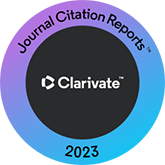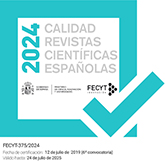Intonation models of yes-no questions in Extremadura
DOI:
https://doi.org/10.3989/loquens.2016.032Keywords:
Phonetics, Phonology, intonation, absolute interrogatives, Extremaduran dialectologyAbstract
This paper is part of a series of studies carried out within the AMPRAE project (Atlas Multimedia de Prosodia de Andalucía y Extremadura), whose main objective is to trace the geoprosodic map of those two dialectal areas in contact (their possible internal system variability, as well as the establishment of prosodic isoglosses and their influence areas). The present paper focuses on absolute interrogative intonation patterns in Extremadura, where the acoustic analysis revealed the existence of two different intonation patterns. This research is based on a range of seven Extremaduran informants (four women and three men), representative of the selected survey points: two urban areas, the capital city of Cáceres and Mérida (Badajoz), and two rural areas, both Badajoz-based, Don Benito and Segura de León (nevertheless, Alburquerque, another Badajoz-based municipality, close to the border with Portugal, is referred to frequently throughout this paper). Once described the intonative behavior of each of the informants, a comparison and contrast of their results is offered in order to identify the convergence and/or divergence among them. The methodology applied is the one set out in the AMPER project.
Downloads
References
Alvarellos Pedrero, M., Muñiz Cachón, C., Díaz Gómez L. y González Rodríguez, R. (2011). La entonación en las variedades lingüísticas de Asturias: estudio contrastivo. Revista Internacional de Lingüistica Iberoamericana, IX, 1(17), 111-120.
Canellada, M. J. (1941). Notas de entonación extremeña. Revista de Filología Española, 25, 79-91.
Congosto Martín, Y. (2007a). Primeras aportaciones a la descripción prosódica del extremeño: Interrogativas absolutas sin expansión en el habla de Don Benito (Badajoz). En M. González González, E. Fernández Rei y B. González Rei (Eds.), III Congreso Internacional de Fonética Experimental (pp. 205-211). Santiago de Compostela: Xunta de Galicia.
Congosto Martín, Y. (2007b). Interrogativas absolutas / declarativas en las hablas extremeñas. Estudio entonativo contrastivo. En J. Dorta (Ed.), La prosodia en el ámbito lingüistico románico (pp. 271-297). Santa Cruz de Tenerife: La Página Ediciones.
Congosto Martín, Y. (2007c). Dialectología de la entonación. Interrogativas absolutas en el español de España (Sevilla, Badajoz) y en el español de América (Bolivia). En J. Dorta (Ed.), La prosodia en el ámbito lingüistico románico (pp. 389-415). Santa Cruz de Tenerife: La Página Ediciones. PMid:17160670
Congosto Martín, Y. (2011). Contínuum entonativo: declarativas e interrogativas absolutas en cuatro variedades del español peninsular y americano. Revista Internacional de Lingüistica Iberoamericana, IX, 1(17), 75-90.
Congosto Martín, Y., Díaz Gómez, L., Viejo Lucio-Villegas, M. y González Rodríguez, R. (2010). Estructura prosódica de los enunciados asertivos e interrogativos del asturiano hablado en Mieres y del extremeño hablado en Don Benito. Estudio descriptivo y comparativo. En M. Iliescu, P. Danler y H. Siller-Runggaldier (Eds.), XXV Congrès Internacional de Linguistique et de Philologie Romanes (pp. 53-67). Berlin, New York: De Gruyter.
Cuevas Alonso, M. y López Bobo, M. J. (2011). Dialectos en contacto y prosodia. Análisis contrastivo. Revista Internacional de Lingüistica Iberoamericana, IX, 1(17), 39-51.
De Castro Moutinho, L., Coimbra, R. L. y Vaz, A. M. (2011). Variación diatópica de la entonación en el portugués europeo continental. Revista Internacional de Lingü.stica Iberoamericana, IX, 1(17), 133-140.
Estebas Vilaplana, E. y Prieto Vives, P. (2008). La notación prosódica del español: una revisión del Sp_ToBI. Estudios de Fonética Experimental, 17, 265-283.
Fernández Planas, A. M. (2005). Aspectos generales acerca del Proyecto Internacional AMPER en España. Estudios de Fonética Experimental, 14, 13-27.
Flores del Manzano, F. (1988). Incidencia del factor histórico en la configuración geolingüística de Extremadura. En M. Ariza, A. Salvador y A. Viudas (Eds.), Actas del I Congreso Internacional de Historia de la Lengua (Vol. 2, pp. 1454-1459). Madrid: Arco/Libros.
González Salgado, J. A. (2001). Fuentes del vocabulario y áreas léxicas de Extremadura. En A. Veiga, M. González Pereira y M. Souto Gómez (Eds.), De lenguas y lenguajes (pp. 125-139). La Coruña: Editorial Toxosoutos.
López Bobo M. J. y Cuevas Alonso, M. (2009). ¿Prosodia norteña o castellana? Aproximación a la entonación del oriente de Cantabria. Estudios de Fonética Experimental, 18, 217-236.
López Bobo, M. J., Muñiz Cachón, C., Díaz Gómez, L., Corral Blanco, N., Brezmes Alonso, D. y Alvarellos Pedrero, M. (2007). Análisis y representación de la entonación. Replanteamiento metodológico en el marco del proyecto AMPER. En J. Dorta y B. Fernández (Eds.), La prosodia en el ámbito lingüistico románico (pp. 17-34). Santa Cruz de Tenerife: La Página Ediciones.
Montero Curiel, P. (2006). El extremeño. Madrid: Arco/Libros.
Pamies Bertran, A., Fernández Planas, A. M., Martínez Celdrán, E., Ortega Escandell, A., y Amorós Céspedes, M. C. (2002). Umbrales tonales en español peninsular. II Congreso Nacional de Fonética Experimental. Sevilla: Universidad de Sevilla.
Romano, A., Contini, M., Lai, J. P., y Rilliard, A. (2011). Distancias prosódicas entre variedades románicas en el marco del proyecto AMPER. Revista Internacional de Lingü.stica Iberoamericana, IX, 1(17), 13-25.
Published
How to Cite
Issue
Section
License
Copyright (c) 2016 Consejo Superior de Investigaciones Científicas (CSIC)

This work is licensed under a Creative Commons Attribution 4.0 International License.
© CSIC. Manuscripts published in both the print and online versions of this journal are the property of the Consejo Superior de Investigaciones Científicas, and quoting this source is a requirement for any partial or full reproduction.
All contents of this electronic edition, except where otherwise noted, are distributed under a Creative Commons Attribution 4.0 International (CC BY 4.0) licence. You may read here the basic information and the legal text of the licence. The indication of the CC BY 4.0 licence must be expressly stated in this way when necessary.
Self-archiving in repositories, personal webpages or similar, of any version other than the final version of the work produced by the publisher, is not allowed.














